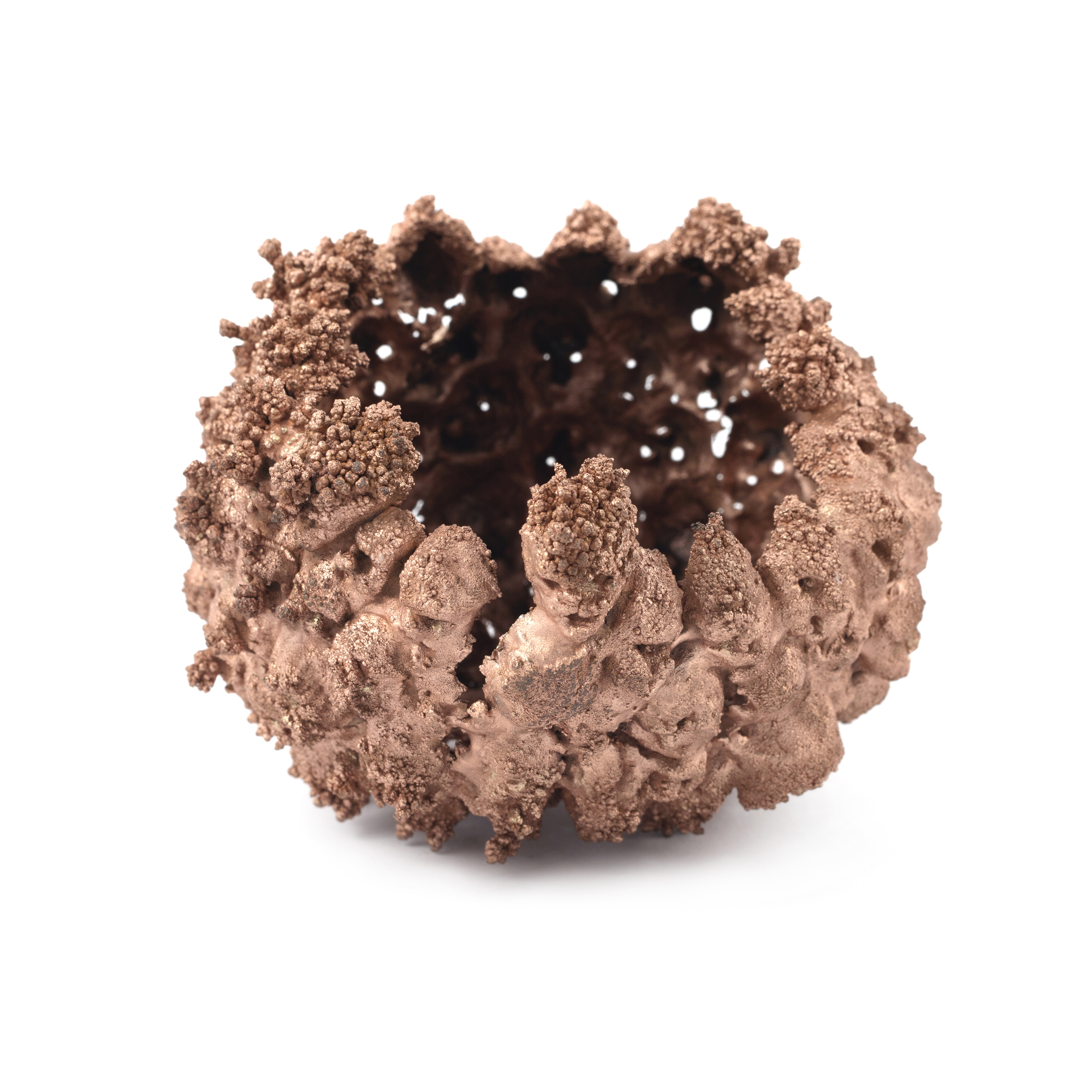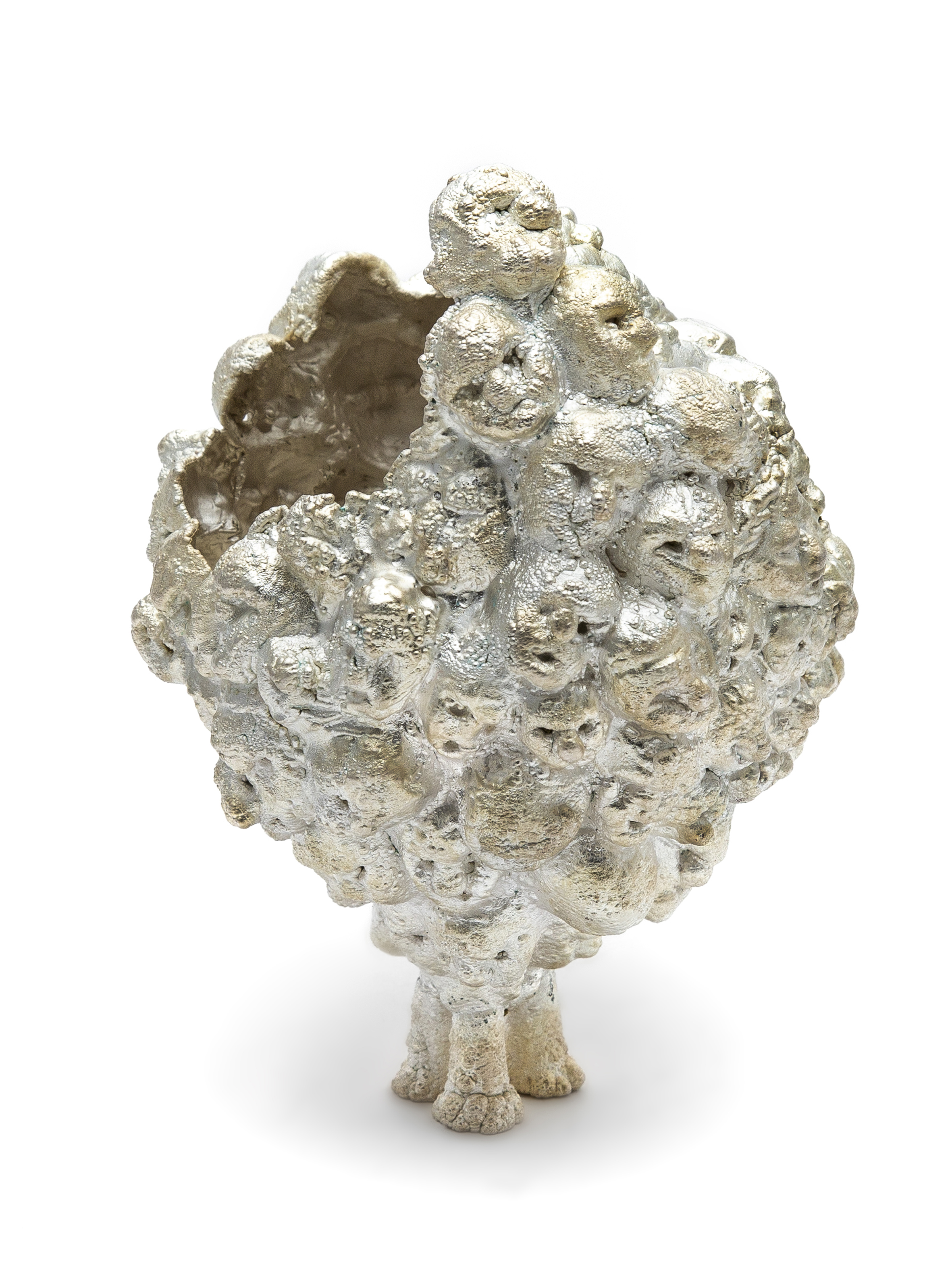Chorus - vessels
from memory














Chorus
from memory
2021 -2022
(...) because you remember, and memory is always a second chance (...)
(...) strange what a face can do to a face (...)
Ocean Vuong
Maria Walker's VESSELS works with the expansive notion of deformation by
electricity - electroforming baths - copper molecules attach themselves to the sculpture,
explode and deform. The structure dissipates, and only traces of the original
form remain: vessels filled with the containment of deformed faces.
The oeuvre proposes the dissatisfaction of not reconstructing a single truth, of a single face - the Barthian notion of face. We are before a face expanded in its quantity, multiplied and deformed - already remembered.
The artist decides to interpret the notion of oblivion in her country's most exported material: copper, as if what is essential is not the material but its ability to deform. Why choose to deform something when the image is already assembled? It is a double deformation, melting a national identity and a choir of faces - undefined in their gender. Questions that arise from these vessels: How do you put materials together in order to forget? How do you export and bring the pain back to copper? This is a work of art about pain, which solidifies pain going back to a face that is returning to pain.
The cumulative factor suggests that repetition is the only form of oblivion. The performative quality of the artwork lies here: in the extreme and constant action of reassembling and deforming repeatedly. The artist undermines the thesis that there is danger in the present. This series of works is dangerous for the melancholy that lies beneath the following question: What can a face do to a face just by being remembered? The gesture we see in the devices is a choral rictus. It reminds us of Bacon's faces through its sonic traits. In these vessels, the eyes and mouth possess the same features. It is as if cries of pain didn’t only originate from the mouth, but can also be shouted using all facial muscles, providing sonorous materiality to the vessels, like an archive of screams.
Through the use of electricity, we return to the concept of trauma and how, by bringing an amputated limb back to life from an unnamed body that we have no intention of bringing back to life. The only intention is to make it scream. These faces of pain accumulate and provide the thesis that pain is deformation. As long as remembrance exists, there will be pain.
In this series, there is an allusion to pre-Columbian vessels that store pain: reliquaries that won't save you from nightmares but allow you to see the horror. These vessels Carrey the past and do not help escape. It does not bet on what is general - the work is extremely intimate.
The artist suggests a journey back to childhood; it returns to the dark collective imagination of a child from the speech of terror. She returns to the fable of the monster. They are bubbling, atomic, monstrous faces: Les Yeux sans visage. This makes it impossible for us as spectators to access the work. We only have access to a vestige of what happened, to a repeated story known by everybody, but that nobody really knows in detail.
The work freezes before extinction. What is the last gesture that occurs before death? Is this last gesture ever portrayed? Only through these faces we are able to witness a horror to which there is no direct access. Therefore, the spectator enters a collective imagination of horror, not the explicit, absolute horror. Only the artist knows what has happened and places these faces as witnesses of that violent, explosive, repulsive, and decisive scene, which freezes a moment: in copper, and in time. We are before a work of pre-extinction. It replicates a person one thousand times to eradicate them; a face that is all the faces. And horror is to be able to be all the faces. As Heiner Muller says: it is easier to learn how to torture than to describe torture.
The oeuvre proposes the dissatisfaction of not reconstructing a single truth, of a single face - the Barthian notion of face. We are before a face expanded in its quantity, multiplied and deformed - already remembered.
The artist decides to interpret the notion of oblivion in her country's most exported material: copper, as if what is essential is not the material but its ability to deform. Why choose to deform something when the image is already assembled? It is a double deformation, melting a national identity and a choir of faces - undefined in their gender. Questions that arise from these vessels: How do you put materials together in order to forget? How do you export and bring the pain back to copper? This is a work of art about pain, which solidifies pain going back to a face that is returning to pain.
The cumulative factor suggests that repetition is the only form of oblivion. The performative quality of the artwork lies here: in the extreme and constant action of reassembling and deforming repeatedly. The artist undermines the thesis that there is danger in the present. This series of works is dangerous for the melancholy that lies beneath the following question: What can a face do to a face just by being remembered? The gesture we see in the devices is a choral rictus. It reminds us of Bacon's faces through its sonic traits. In these vessels, the eyes and mouth possess the same features. It is as if cries of pain didn’t only originate from the mouth, but can also be shouted using all facial muscles, providing sonorous materiality to the vessels, like an archive of screams.
Through the use of electricity, we return to the concept of trauma and how, by bringing an amputated limb back to life from an unnamed body that we have no intention of bringing back to life. The only intention is to make it scream. These faces of pain accumulate and provide the thesis that pain is deformation. As long as remembrance exists, there will be pain.
In this series, there is an allusion to pre-Columbian vessels that store pain: reliquaries that won't save you from nightmares but allow you to see the horror. These vessels Carrey the past and do not help escape. It does not bet on what is general - the work is extremely intimate.
The artist suggests a journey back to childhood; it returns to the dark collective imagination of a child from the speech of terror. She returns to the fable of the monster. They are bubbling, atomic, monstrous faces: Les Yeux sans visage. This makes it impossible for us as spectators to access the work. We only have access to a vestige of what happened, to a repeated story known by everybody, but that nobody really knows in detail.
The work freezes before extinction. What is the last gesture that occurs before death? Is this last gesture ever portrayed? Only through these faces we are able to witness a horror to which there is no direct access. Therefore, the spectator enters a collective imagination of horror, not the explicit, absolute horror. Only the artist knows what has happened and places these faces as witnesses of that violent, explosive, repulsive, and decisive scene, which freezes a moment: in copper, and in time. We are before a work of pre-extinction. It replicates a person one thousand times to eradicate them; a face that is all the faces. And horror is to be able to be all the faces. As Heiner Muller says: it is easier to learn how to torture than to describe torture.
Text
Nicolás
Lange / dramaturge - writer - art curated
translation of Bruce Gibbons